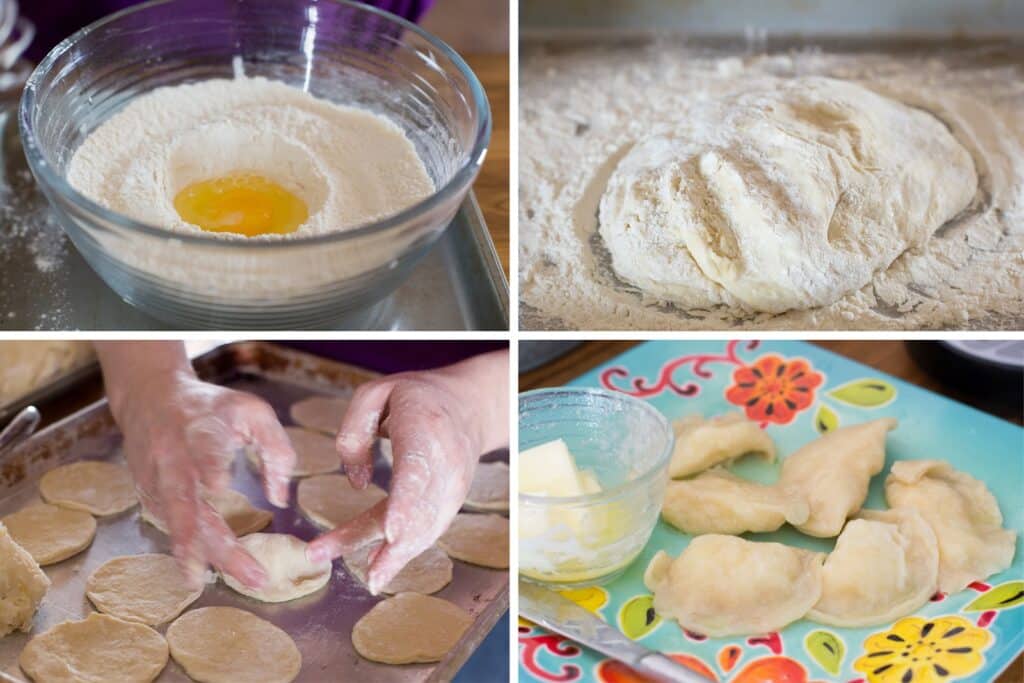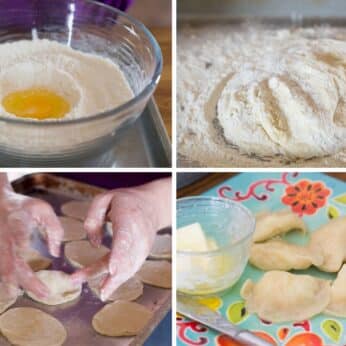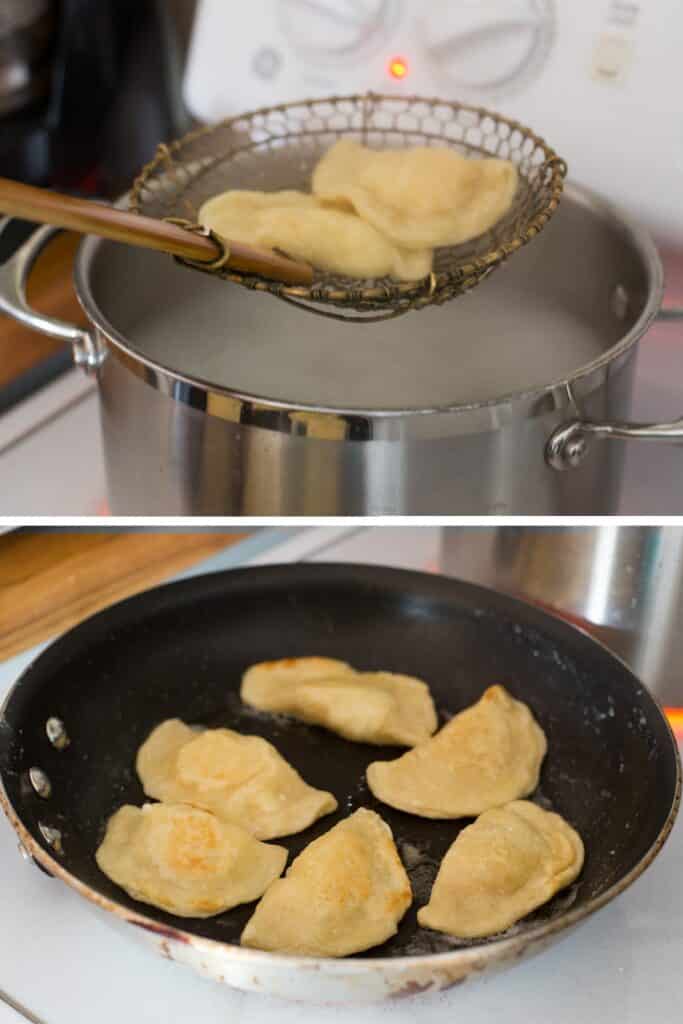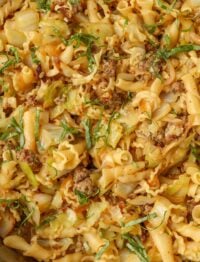Do you know how to make Pierogi? Buttery, crisp Polish Pierogies stuffed with potatoes, cheese, and sauerkraut are a holiday favorite from the very first bite for everyone who tries them.
There are a lot of steps to this Pierogi recipe but don’t let that intimidate you. Anyone can make these! I recommend diving in and making a big batch at one time, so you can freeze some for later.
It’s also a ton of fun to turn Pierogi making into a big event. Grab friends and family and spend an afternoon rolling, stuffing and cooking these delicious dumplings together.

My sister Jenny taught me how to make Polish pierogies years ago; the same way that her Mother-In-Law Jane taught her to make them. Last time we were together for Christmas, we made a double batch of these pierogies and our small crowd ate almost all of them!
Side note: Did you know that the plural for pierogi can be pierogies OR just pierogi? I clarified that with Jane before sharing this recipe for the first time five years ago. And Webster dictionary has confirmed it once again. (Perogies is another spelling I often see, but that one is not in the dictionary.)
Despite the over-explanation here, I know that many of you will still email me to tell me that there is only one way to spell pierogi and I am doing it wrong. All in a day’s work, my friends. I can’t win them all.
What is a Pierogi?
Pierogies are a dough dumpling traditionally stuffed with potatoes, cheese, and/or sauerkraut. First boiled and then fried in butter, these little potato-filled pockets are irresistible.
I’m including our family’s favorite combination of potato, cheese, and sauerkraut in the recipe below. We serve these pierogies with Polish Kapusta and everyone loves the combination.
I’m told that while Jane was growing up, it was common to ask your guests ahead of time whether they preferred potato/cheese or sauerkraut/cheese pierogies. Many people are very particular about their pierogi fillings!
I discovered this for myself when I asked how you all like your pierogies! There are countless other filling options: meats, fruits, vegetables, the combinations are endless.
How To Make Pierogi
Making homemade Pierogi starts with a great filling. Simmer peeled, cut potatoes in a pot of water for 15 minutes until fork tender. Mash the cooked potatoes, then stick them in the fridge to cool completely.
While the potatoes cool, saute the chopped onion in a little olive oil until softened. Add the onion and oil to the cooled potatoes along with the sauerkraut and cheeses.
We learned how to make pierogies with Farmer’s cheese, a pot cheese that comes in a container and is very soft. If you can not locate farmer’s cheese in your market, you can substitute 2 ounces shredded Monterrey jack and 2 ounces ricotta cheese.
Store the filling in the refrigerator until your dough is ready.
Tip: To save time on the day you’re making and serving your pierogies, make the filling a day or two in advance then keep it sealed tight in the fridge until ready to use.
We find it easiest to rotate in batches of six to manage the process most efficiently. 6 waiting, 6 boiling, 6 cooling, 6 frying, repeat. It sounds a little overwhelming initially, but once you have a little assembly line set up, it goes fairly smoothly. We fill 18 pierogies before starting the first batch boiling and then just keep rotating through the stages.
This is a half recipe and it can easily be multiplied for a crowd. We’ve found that this amount is much more manageable, especially for the first few times we made these.
Pierogi Dough
Pierogi dough is a simple mixture of flour, egg, water and just a touch of salt, not unlike homemade fresh pasta.
After mixing together the flour and salt, crack an egg into the center of the bowl and combine with the flour mixture. Gradually add hot water to the bowl until your dough is soft and slightly sticky.
If the dough appears too wet, add more flour a tablespoon at a time. Likewise, if the dough is too crumbly and dry, add more hot water a little at a time.
Chill the dough in the refrigerator for an hour or so until cool and firm.
Pierogi Recipe
- Here comes the fun part. You get to roll out the dough, shape and stuff your pierogies, then give them a bath in boiling hot water.
- Start the water boiling on the stove while you get all your ingredients out of the fridge and ready. Make sure to have a counter space or table cleaned and cleared so you can put the pierogies together without interruption.
- First, divide the dough into four sections. Roll the first section out until it’s very thin, about ⅛ inch in thickness. Cut this section into circles, then place a tablespoon of the potato filling on each side.
- Fold the circles over and pinch the edges to seal. Repeat this with the other sections of the dough and then place your prepared pierogies in a single layer on a plate or pan.
- Plop the dumplings a few at a time into the boiling water. If they stick to the bottom of the pot, give them a quick nudge with a spoon or spatula. When the pierogies rise to the top, scoop them out with a slotted spoon and place them on a buttered plate to cool for a few minutes.
- Once slightly cooled, it’s time to fry your waiting pierogies in butter. Fry a few at a time until the edges are brown and crisp.
Pierogi Making Tips
If you have a team of folks working in the kitchen, you can set up an assembly line to make finishing these steps quicker and easier. Have someone assembling the dumplings, someone boiling, and someone frying.
We find it easiest to rotate in batches of six to manage the process most efficiently. 6 waiting, 6 boiling, 6 cooling, 6 frying, repeat.
We fill 18 pierogies before starting the first batch boiling and then just keep rotating through the stages. The recipe below has been halved from Jane’s original recipe and it can easily be multiplied for a crowd. We’ve found that this amount is much more manageable, especially for the first few times we made these.
You’ll be ready to sit down to a delicious, buttery plate full of Polish Pierogies in no time. These are satisfying enough all on their own as a snack, appetizer or even a meal.
Pierogies pair especially well with cabbage dishes like this Cabbage and Sausage Skillet, Layered Cabbage Rolls, White Beans and Cabbage, or this Spicy Cabbage.
This recipe includes my family’s standard filling of potato, sauerkraut, and cheese but you can use this same recipe as a guideline for cooking Pierogies with any kind of filling you like.
Leftover pierogies freeze like a charm, too! Place them on a single layer on a cookie sheet until just frozen (an hour or two) before sealing them in airtight containers and storing in the freezer.
Kitchen Tip: I use this pot, this pan, and this spider to make this recipe.

Polish Pierogi Recipe: Step-By-Step Recipe with Photographs
Ingredients
FILLING INGREDIENTS
- 4 medium size potatoes any variety will work, peeled and cut into 1″ pieces
- 1 teaspoon olive oil
- 1/2 small onion chopped small about ⅓ cup
- 1/2 14 ounce can sauerkraut
- 4 ounces farmer’s cheese *
DOUGH INGREDIENTS
- 2 1/2 cups all purpose flour plus more for kneading
- 1 teaspoon kosher salt
- 1 large egg
- ¾ – 1 cup very hot water
FOR SERVING
- 3/4 cup butter melted
- Toppings: sour cream applesauce
Instructions
FILLING INSTRUCTIONS
- Place the potatoes in a large pot and cover with water. Bring to a boil and then simmer until fork tender, about 15 minutes. Drain the water and mash the potatoes. Place the potatoes in a mixing bowl and chill in the refrigerator until cold.
- In a small skillet over medium heat, warm the oil and then saute the onion until tender. Let them cool for a few minutes and then add the cooked onions to the bowl of cold mashed potatoes. Place the sauerkraut in a strainer and rinse very well under running water, for at least 3 minutes. Drain thoroughly and add the sauerkraut to the bowl with the potatoes. Add the cheese and stir to combine. Store in the refrigerator until ready to make the pierogies. The filling can be made a day or two in advance and refrigerated until needed.
DOUGH INSTRUCTIONS
- Place the flour and salt in a large bowl and stir to combine. Make a small well with your hand and crack the egg into it. Stir to combine and then gradually add the hot water, mixing with your hands until the dough is very sticky and well combined. If it becomes too sticky and wet, add just a tablespoon or so more flour. The photo on the left is too wet, the one on the right (with the spoon in the bowl) is perfect. Chill the dough in the refrigerator for at least an hour.
COOKING INSTRUCTIONS
- Bring a pot of water to a boil. Sprinkle a large board with flour. Transfer the dough to the floured surface and flip it over a few times to coat with flour. Gently knead the dough just a few times with your hands, adding a sprinkling of flour as needed.
- To Shape Pierogies: Divide the dough into four sections and roll out one of the sections very thin, to about 1/8" thickness. (This should be just a bit thinner than a pie crust.) Cut into circles and place 1 tablespoon of the potato filling on one side. Fold over the circle and pinch around the dough. Place the prepared pierogies in a single layer onto a waiting plate. Don't stack them or the dough will stick together.
- To Boil Pierogies: Drop the waiting pierogies into the water, a few at a time. Use a spoon or spatula to gently nudge them off the bottom of the pot if they stick. When they float to the surface of the water, lift them out carefully with a slotted spoon. Place them on a buttered plate and drizzle a small amount of melted butter on top of them to prevent sticking together. Let the boiled pierogies cool for a few minutes before frying them.
- To Fry Pierogies: In a large skillet over medium heat, melt a tablespoon of butter. When the butter sizzles, place the boiled pierogies in the skillet in a single layer. Let them cook 2-3 minutes, until lightly browned on the edges, flip over and repeat. The pierogies will not turn brown all over, but the edges should crisp and be light brown. Remove the finished pierogies to a buttered baking dish.
Notes
Nutrition
{originally published 2/20/14 – recipe notes and photos updated 8/12/21}









Jo says
You are amazingly patient with all those being super abusive about the spelling. For that alone I give you 5 stars. Thanks for sharing this wonderful recipe and helpful tips.
Chris says
Love this recipe! I use it for ravioli too! Can it be frozen? Thought I had potatoes and I do not and am in the middle of a snowstorm. Thanks!
Alida says
This recipe sounds wonderful, however, I would really like some fruit pierogi. I have only tried plum pierogi. Thank you in advance. Alida
Jean says
Hi Mary have you ever used cottage cheese in your pierogies my grandma made these and we love them just boil them and put butter on top or for a nice crispy fry them After you boil them they are delicious And I use milk instead of water
Amanda says
I can’t believe I have never made these before! I always wanted to but was intimidated, I now don’t know why because they were very simple to make. I did three russets potatoes that were quite big so I ended up making a second batch of dough for the rest of the filing. I gave a bag of 12 or so to my dad and still have so many. I had them for dinner two nights and froze the rest and still have a gallon bag full of them. So awesome for quick easy meal nights, I really loved the sauerkraut in the filing as well. I served pan fried with bacon, cheese and greek yogurt mixed with hot sauce.
Mary Younkin says
I’m so happy to hear the pierogi were a hit, Amanda!
Rich says
When I’ve made these I also added the farmers cheese and some potato to the dough, gives the dough that umami taste of wow.
Marty says
No comments just want Pierogi receipts.
Kate says
How long can the prepared dough be stored in the refrigerator?
I’m looking forward to making these tomorrow. We made pierogies every year with my mom for a long time and I’m carrying on the tradition at my home now!
Mary Younkin says
I would not suggest storing the dough for more than a day or two, Kate.
Mari Kiesel says
I LOVE your recipes and they bring back such great memories of family holidays!
I do make pierogi and even make a dessert one. I take a can of blueberry, apple or cherry pie filling,
gently boil the pierogi then sauté them in melted butter, sugar and cinnamon and serve with vanilla ice cream….Delicious. Have a Blessed Christmas!
Mary Younkin says
Dessert pierogi sound fantastic, Mari. I’m so happy to hear that you’re enjoying the recipes.
Constance Cantrell says
This is also my Polish grandmothers recipe. Thanks for the great instructions and tips. We make blueberry pierogi for Christmas. Just add fresh blueberries, no sugar, into a pocket (about 4 berries per) and boil separately from other flavors (we run 2 pots of water) because they bleed. Then fry in butter when you eat like the others. My kids like a little sprinkled sugar when done in frying pan but I prefer sour cream. Enjoy!
Mary Younkin says
oooh! I bet the blueberry pierogies are fantastic, Constance. Thanks for sharing that!
GL says
Pierogies 🙁 who calls them that…
Mary Younkin says
People who make Pierogies. . .
Renee says
This was the best dough recipe I have found. I did double it. I used all the water and because my eggs were small I put one extra one in. I also used the potato water for my water. These were soft, easy to manage. My husband is the dough roller and he was impressed.
Mary Younkin says
I’m so happy to hear that you loved the recipe, Renee!
Judy Pfister says
Can I freeze these before cooking? We do that with homemade ravioli. Do I then defrost before boiling or do so frozen?
Mary Younkin says
Yes, I thaw them in a single layer on a plate or tray before cooking.
Mary Younkin says
Reading your comments is so heartwarming and I just love that the recipe worked so well for you.
Keith N says
My father’s parents were from Poland and I grew up in Luzerne County, Pennsylvania, where the population is mostly of Polish descent. 33 years ago, I moved out of state and hadn’t eaten Polish food for years. Lately, I’ve wanted to make all the Polish dishes I ate when I was growing up. I recently made pierogies using this recipe and they were wonderful. I followed the recipe to a T with the following exceptions: One, I didn’t put sauerkraut in all of the pierogies. I made half of them with sauerkraut inside among the potatoes, onions and farmer’s cheese and half of them with only potatoes, onions and cheese. One of my aunts from the non-Polish side of my family used to fill some of her pierogies with sauerkraut and prunes and I’ll also give that a try one of these days.
The other way that I didn’t follow this recipe exactly was in using mashed potato flakes instead of making mashed potatoes with fresh potatoes. I’ve made homemade mashed potatoes before with ease so it wasn’t because I couldn’t do it. I chose this option because I have 5 boxes of potato flakes that are past their expiration date, so I wanted to use them up before they start tasting bad. By doing this I learned something that I’d like to pass on to anyone who wants to try this recipe using potato flakes instead of fresh potatoes: Make enough mashed potatoes for 4 servings. That will be the right amount for this recipe.
Finally, I fried the pierogies in a mixture of olive oil and butter with onions and I highly recommend this to others. The onions really improve the flavor of the pierogies. Anyway, I just wanted to thank you for posting this recipe. The pierogies I made with this recipe were as good as the homemade pierogies my aunt used to make.
Mary Younkin says
I am so happy you enjoyed the recipe, Keit. Thank you for sharing what worked for you.
Keith N. says
Thank you, Mary. There’s another Polish dish you may want to try. It’s called golabki, but where I grew up, everyone I knew called them pigs in the blanket or piggies. They’re ground pork and rice wrapped in a cabbage leaf, covered in a tomato sauce and then boiled or baked in an oven. They’re like stuffed peppers but cabbage is used instead of peppers. I never made them but my maternal grandmother and one of my maternal aunts made them often. I don’t remember how they made them but I suspect they baked them rather than boiling them. Anyway, I wish you the best.
Mary Younkin says
I will have to give that a try. Thank you for the suggestion.
Maria says
Do I add more cheese if I’m not using sauerkraut?
Mary Younkin says
You certainly can, Maria. Personally, I don’t enjoy sauerkraut all that much, but it works very well here. So, I’ve never tried swapping it.
Wayne Weber says
I’ve been trying to find a recipe that was the same as my grandmothers and my father. When I read this I was overjoyed. Exactly as dad’s and grandmas. Grandma said her grandma made it this wonderful dish. They were Polish from the old country. And we’re wonderful cooks. Thank you
Mary Younkin says
Thank you so much for your kind words, Wayne. I am so happy this recipe brings back such fond memories for your family. Messages like yours are why I love sharing these recipes and traditions with others.
Lori says
I just wanted to say thank you for this recipe! I’ve been using it for the last few years to make pierogi on Good Friday. I also wanted to mention that I’m a Texas transplant, there aren’t many Polish folks here’s so farmer’s cheese is nonexistent. I found I it one year before the one and only place that carried it discontinued it. So after much research, I resorted to Velveeta queso blanco cubes. Not the same, but it works surprisingly well! So if anybody finds themselves in an area where farmer’s cheese isn’t sold, it’s a pretty good substitute!
Mary Younkin says
I’m happy to hear that you’re enjoying the pierogies, Lori!
Keith N says
I was able to find only one store in my area that had farmer’s cheese. It made me wonder if there’s another cheese I could use in the event that this store goes out of business or it stops selling farmer’s cheese. I looked online to see if other kinds of cheese are suitable for making pierogies. I found that goat cheese or ricotta cheese were the recommended substitutes. I haven’t tried making pierogies with ricotta cheese yet, but I recently made a batch of pierogies with goat cheese and it tasted the same as the pierogies I’ve made with farmer’s cheese. I couldn’t tell the difference. If you can’t find farmer’s cheese where you live, goat cheese will work just as well.
Mary Younkin says
Goat cheese should be an excellent substitute, Keith. I’m glad you were able to sort out the problem. I hope you continue to love the pierogies!
Delena Holcer says
Best recipe by far!!! Love the consistency of the dough. Easy to roll and easy to seal. You can also easily roll the dough more than once!!
Mary Younkin says
I’m happy to hear it, Delena!